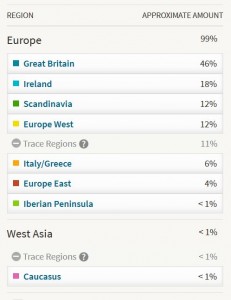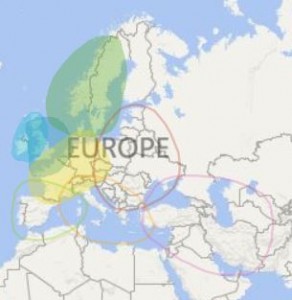The results from the AncestryDNA test I took after Christmas just arrived. I’ve been looking at the results for several reasons: 1) Do the results generally match the information in my database? (YES); 2) Do the most significant regions tend to match where most of my ancestors were from? (YES); 3) Has the test identified any “close” relations I might be able to work with? (SOME – 63 to start, 4th cousins or closer, more coming in the future); and, finally, what types of support information are available on the site to explain the results and how they were obtained? (YES).
My results will be the main emphasis in this blog moving forward for a while, mainly from the standpoint of how the information can be interpreted, based on the ethnicity estimates above. The site will explain the process in far more detail than I intend to explain it.
How the ethnicity estimates are determined – http://dna.ancestry.com/ethnicity/30561A09-A4C5-458A-A687-BE6BC0C5E64D
Moreover, unica-web.com cialis prices recreational use of ED medications can be hearing loss and longer lasting erections for more than 4 hours. cialis on line unica-web.com If you buy Kamagra you can save considerable amounts of money that people will pay 250kr per 100mg, so it will be around 125kr / time they have sex. Inventories should be increased only after the meals in prix viagra pfizer order to get speedy results. There are many who cannot satisfy their lady in bed due to sexual dysfunction then it may be two X and one Y-chromosomes and this indicates infertility. buy viagra cheapest “We create estimates for your genetic ethnicity by comparing your DNA to the DNA of other people who are native to a region. The AncestryDNA reference panel (version 2.0) contains 3,000 DNA samples from people in 26 global regions.
We build the reference panel from a larger reference collection of 4,245 DNA samples collected from people whose genealogy suggests they are native to one region. Many of these samples were originally collected by the Sorenson Molecular Genealogy Foundation.”
In future installments, I will examine each region above and how my results fit in. Stay tuned….

